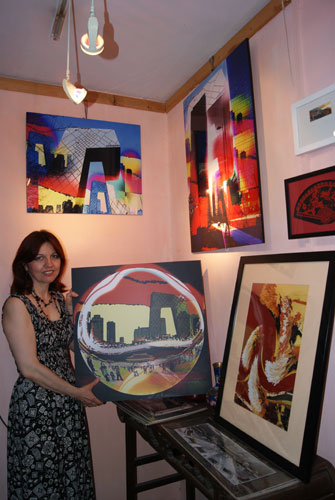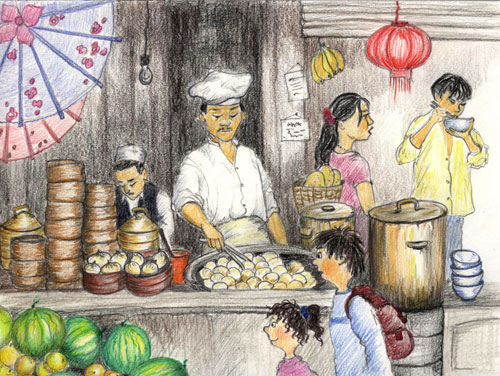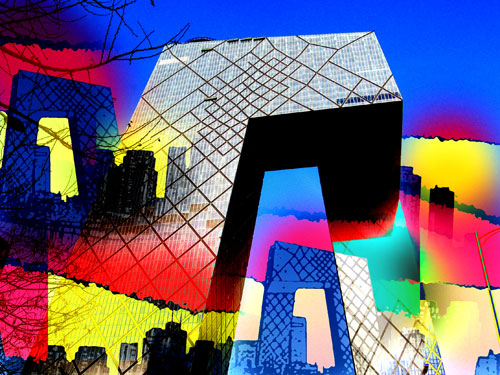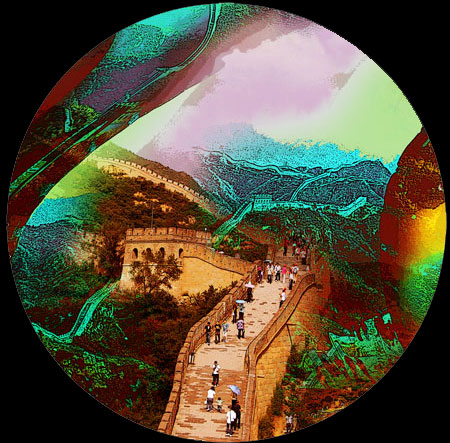German artist savors watching people
Her pictures can be found as far afield as the USA and Canada, Europe, the Middle East, South Africa and South East Asia; but now artist Angi (real name Agnes Nadkarni) is starting to carve out a name for herself in China, having recently been the featured artist of the month at the HongYi Gallery in the Sanlitun district of Beijing.

Born of Hungarian and German parents, she has lived in Germany, Hungary, Dubai and China, the latter for a total of nearly five years - first in Shanghai and more recently in Beijing.
“Some of my Chinese friends had difficulty pronouncing ‘Agnes’, and as more and more of them started to call me Angi the name somehow stuck, to the point where I now introduce myself as that,” she explains.
“I can remember when I was about four years old, sitting at home by the open window, waiting for my mother to return from the shops, I used to amuse myself by drawing people dancing and ice skating. I must have drawn hundreds of such pictures; always people, never buildings, which don’t have the flexible curves that people have.”
Following her studies in both Budapest and the Nürnberg College of Graphic Design, where she specialized in illustration work, her early paid work involved book illustrations, artwork for web sites and creating advertising materials for companies such as Volkswagen.
But her life changed in dramatic fashion when her husband, who works for the German company, Siemens, was posted to work in Shanghai in 1999. “I spent a wonderful three years there,” Angi recalls, “and we all had such an amazing adventure that I felt I had to write about it, not least for my children Swen and Anita, so they would not forget their experiences there.”
‘Swen’s Abenteuer in China’ (Swen’s Adventures in China) was Angi’s first book, for which she also drew a number of illustrations of Shanghai street scenes. It was published in Germany and a dual German/English version is currently in production for use in language lessons in German schools.

“It was my very first experience of living and working among Chinese people whom I found to be warm, open minded and friendly to foreigners,” she continues, “and I just knew I would want to return again and again.”
But fate had other plans for her. On their return to Germany, Angi signed up for some advanced computer graphics courses, in order to explore many of the new techniques that were being introduced by the software companies. “I was especially fascinated by the filters in Photoshop and at some of the effects that could be created so easily compared with traditional hand drawn methods; and this introduced me to a whole new vista of possibilities.”
Her husband’s next posting was to Dubai for three years and it was here that her international popularity started to take off. “Until then I had really been concentrating on doing portraits of people; but here I found a strong expatriate market with many wanting something to remember their time in the Middle East by. There wasn’t really a demand for portraiture. What people wanted was a record of some of Dubai’s iconic buildings such as the Burj al Arab, together with camels and Arabs in traditional costume thrown in for good measure,” she remembers.
“So in a way, it was almost by accident that I developed a technique that I call ‘Photo-Design’. I would start off taking photos of interesting architecture and once back in my studio would look for similarities and contrasts between different pictures that I could then use to create a montage of photographic extracts which were individually manipulated using these special computer filters.”
It was during an art fair in Abu Dhabi that she was approached by a company wishing to use her work as the basis for postcards, wall posters and other decorations. “Until then you could buy virtually identical postcards across the Gulf all showing basically the same shots of the same buildings. Finally, they had something new they could sell.”
Nearly two years ago, Angi’s husband was transferred yet again – but this time back to China. So the family set themselves up in Beijing where Angi took up the reigns of her photo-design business once more and applied it to the Chinese market.
“In Beijing, everything is so different from the Middle East,” she continues. “In Dubai and Abu Dhabi people were always asking me for greetings cards and wall decorations; but here there is much less demand from individuals and more from companies wanting unique items for festivals such as Christmas and Chinese New Year to send to their clients.

“Again, I have noticed a difference in taste between what Europeans like and what is preferred by Asians. Westerners tend to like stronger colors and more modern themes,” (one of Angi’s favorite buildings in Beijing is the new CCTV Headquarters), “while the Chinese tend to prefer traditional scenes such as Hutong areas, the Great Wall and palace complexes.”

When accepting commissions for her work, Angi always tries to ensure she is on the same wavelength as her clients. “A company might want to have their office building, logo or products incorporated into a design, which, of course, I am very happy to do; but I also like to see if they have any preferences on colors or styles which are highly individualistic.”

Angi admits that she still greatly misses Shanghai which she describes as an exciting city full of life. “But I also love Beijing in a totally different way. It is fascinating, full of history and beautiful buildings and I find it truly inspiring.
“Either way I will stay in China for at least another two years; but I would like to think I will be here in Beijing for quite some time after that!”
